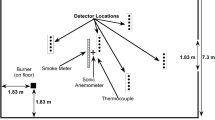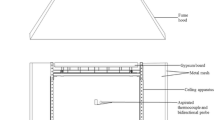Abstract
Recently developed methods to calculate the time required for ceiling mounted heat and smoke detectors to respond to growing fires are reviewed. A computer program that calculates activation times for both fixed temperature and rate of rise heat detectors in response to fires that increase in heat release rate proportionally with the square of time from ignition is given. This program produces nearly equivalent results to the tables published in Appendix C, Guide for Automatic Fire Detector Spacing (NFPA 72E, 1984). A separate method and corresponding program are provided to calculate response time for fires having arbitrary heat release rate histories. This method is based on quasi-steady ceiling layer gas flow assumptions. Assuming a constant proportionality between smoke and heat released from burning materials, a method is described to calculate smoke detector response time, modeling the smoke detector as a low temperature heat detector in either of the two response time models.
Similar content being viewed by others
Abbreviations
- A:
-
g/(c p T∞ ϱ ∞)
- c p :
-
specific heat capacity of ambient air
- C s :
-
smoke mass concentration
- D:
-
effective binary diffusion coefficient
- g:
-
acceleration of gravity
- H:
-
vertical distance from fuel to ceiling
- I:
-
light intensity
- Io :
-
initial light intensity
- L:
-
light beam length
- \(\dot m\) ‴ s :
-
smoke gas mass production rate per unit volume
- OD:
-
optical density per unit length (see Equation 8)
- \(\dot Q\) :
-
fire energy release rate
- \(\dot Q\) ‴ :
-
energy release rate per unit volume
- r:
-
radial distance from fire axis to the detector
- RTI:
-
response time index, the product of the detector thermal time constant and the square root of the gas speed used in the test to measure the time constant.9
- t:
-
time
- t *2 :
-
dimensionless time t/[A−1/5 α −1/5 H4/5)
- (t *2 ) f :
-
dimensionless time for time delay for gas front travel
- T∞ :
-
ambient temperature
- T:
-
gas temperature at detector location
- T s :
-
temperature of detector sensing elements
- ΔT:
-
T — T∞
- ΔT *2 :
-
dimensionless temperature differences ΔT/[A2/5(T f /g)α 2/5 H−3/5]
- U:
-
gas speed at the detector location
- U *2 :
-
dimensionless gas speed U/[Aα H]1/5
- Y s :
-
local ratio of smoke mass to total mass in flow
- α :
-
proportionality constant for t2-fire growth = Q/t2
- ϱ ∞ :
-
ambient air density
References
Alpert, R. L., “Calculation of Response Time of Ceiling-Mounted Fire Detectors,”Fire Technology, 8, 1972, p. 181.
Alpert, R. L., “Turbulent Ceiling-Jet Induced by Large-Scale Fires,”Combustion Science and Technology, 11, 1975, p. 197.
Heskestad, G., and Delichatsios, M. A.,Environments of Fire Detectors Phase 1; Effects of Fire Size, Ceiling Height and Material, Volume II — Analysis. Technical Report Serial No. 22427, RC 77-T-11. Factory Mutual Research Corporation, Norwood, MA, 1977.
Heskestad, G., and Delichatsios, M. A., “The Initial Convective Flow in Fire,”Seventeenth Symposium (International) on Combustion, The Combustion Institute, Pittsburgh, PA, 1978, pp. 1113–1123.
Standard on Automatic Fire Detectors, NFPA 72E-1984, Appendix C, National Fire Protection Association, Quincy, MA.
Evans, D. D., “Calculating Sprinkler Actuation Time in Compartment,”Fire Safety Journal, Vol. 9, No. 2, July 1985, pp. 147–155.
Tewarson, A., and Pion, R., “A Laboratory-Scale Test Method for the Measurement of Flammability Parameters,” FMRC serial No. 22524, Factory Mutual Research Corporation, Norwood, MA, Oct. 1977.
Beyler, C. L., “A Design Method for Flaming Fire Detection,”Fire Technology, 20, 4, 1984, p. 5.
Heskestad, G., and Smith H.,Investigation of a New Sprinkler Sensitivity Approval Test: The Plunge Test, FMRC Technical Report 22485, Factory Mutual Research Corporation, Norwood, MA, 1976.
Evans, D. D., and Madrzykowski, D.,Characterizing the Thermal Response of Fusible-Link Sprinklers, NBSIR 81-2329, National Bureau of Standards, Washington, DC, 1981.
Seader, J., and Einhorn, I., “Some Physical, Chemical, Toxicological, and Physiological Aspects of Fire Smokes,”Sixteenth Symposium (International) on Combustion, The Combustion Institute, Pittsburgh, PA, 1976, pp. 1423–1445.
Tewarson, A.,Physico-Chemical and Combustion/Pyrolysis Properties of Polymeric Materials. FMRC J.I. OEONG.RC, Factory Mutual Research Corporation, Norwood, MA, Nov. 1980, p. 27.
Author information
Authors and Affiliations
Additional information
Reference: David D. Evans and David W. Stroup, “Methods to Calculate the Response Time of Heat and Smoke Detectors Installed Below Large Unobstructed Ceilings,”Fire Technology, Vol. 22, No. 1, February 1985, p. 54.
Note: This paper is a contribution of the National Bureau of Standards and is not subject to copyright.
Rights and permissions
About this article
Cite this article
Evans, D.D., Stroup, D.W. Methods to calculate the response time of heat and smoke detectors installed below large unobstructed ceilings. Fire Technol 22, 54–65 (1986). https://doi.org/10.1007/BF01040244
Issue Date:
DOI: https://doi.org/10.1007/BF01040244




